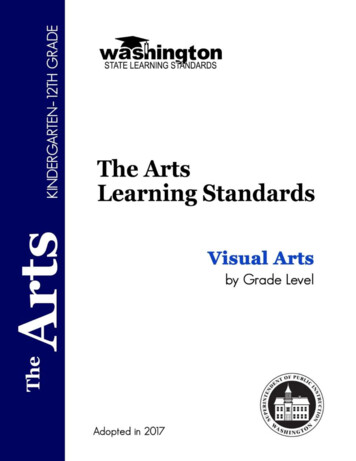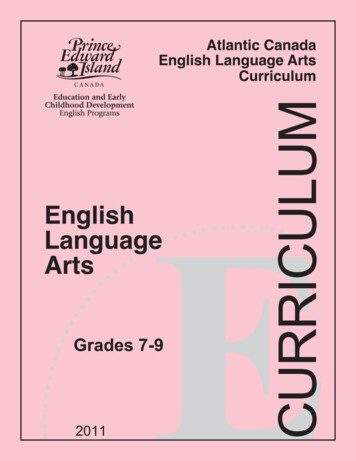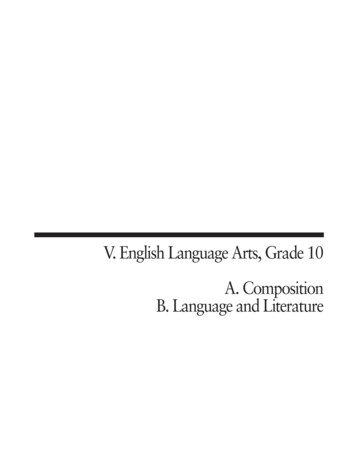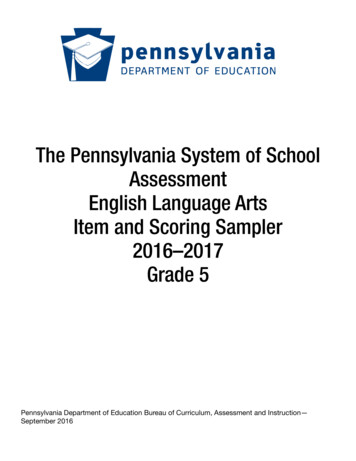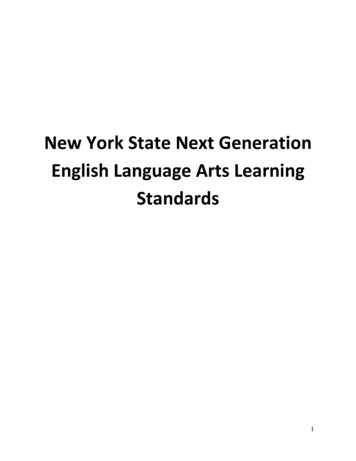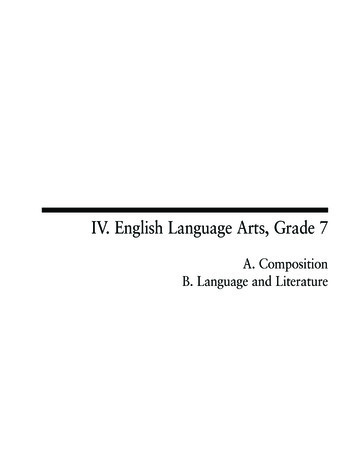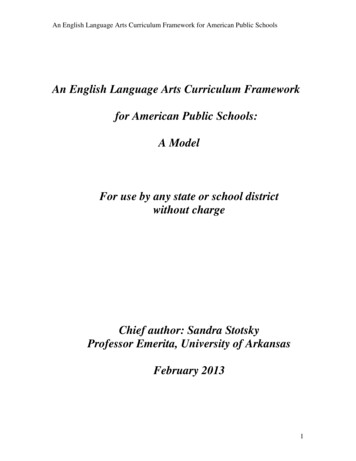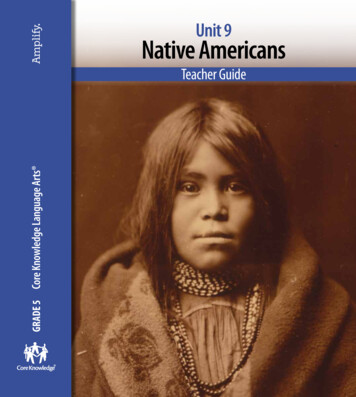
Transcription
Grade 5 Core Knowledge Language Arts Unit 9Native AmericansTeacher Guide
Unit 9Native AmericansTeacher GuideGrade 5Core Knowledge Language Arts
ISBN: 978-1-942010-25-8Copyright 2014 Core Knowledge Foundationwww.coreknowledge.orgAll Rights Reserved.Core Knowledge Language Arts is a trademarkof the Core Knowledge Foundation.Trademarks and trade names are shown inthis book strictly for illustrative and educationalpurposes and are the property of theirrespective owners. References herein shouldnot be regarded as affecting the validity of saidtrademarks and trade names.
ContentsNative AmericansTeacher GuideIntroduction 1Lesson 1 9Core ConnectionsReading Review Prior Knowledge Read-Aloud: Chapter 1 “A Long and Winding Road” Word Work: TensionLesson 2 31ReadingGrammarMorphologyWriting Small Group: Chapter 2 “Across Mountains andPrairies” Identify Shiftsin Verb Tense IntroduceSuffixes –tionand –sion Introduce aPersuasiveEssay Word Work: CustomLesson 3 55ReadingWriting Partner: Chapter 3 “Tales from the Great Plains” Identify Parts of a Persuasive Essay Word Work: RemnantLesson 4 64ReadingGrammarMorphologyWriting Small Group: Chapter 4 “The Changing Landscape ofCalifornia” Identify andCorrect Shiftsin Verb Tense PracticeSuffixes –tionand –sion Evaluate aPersuasiveEssay Using aRubric Word Work: ImmunityLesson 5 86ReadingWriting Close Reading: Chapter 4 “The Changing Landscapeof California” Select a Persuasive Essay Topic and Collect RelevantInformation Word Work: NimbleLesson 6 104ReadingGrammarMorphologySpelling Small Group: Chapter 5 “Rainforests, Rivers, andOcean” IntroduceTransitionalWords andPhrases ThatShow Time IntroduceRoot mem IntroduceSpellingWords Word Work: DistinctCore Knowledge Language Arts Grade 5Unit 9iii
Lesson 7 126ReadingWriting Read-Aloud: Chapter 6 “Myths from the PacificNorthwest” Plan and Draft a Persuasive Essay Word Work: MeekLesson 8 139ReadingWriting Small Group: Chapter 7 “Severing Ties” Plan and Draft the Body of a Persuasive Essay Word Work: EncroachLesson 9 158ReadingGrammarMorphologySpelling Close Reading: Chapter 7 “Severing Ties” TransitionalWords andPhrases ThatShow Time PracticeRoot mem PracticeSpellingWords Word Work: ProsperLesson 10 171SpellingReadingWriting Assessment Partner: Chapter 8 “Your Name is Luther” Draft the Body of a PersuasiveEssay Word Work: ExperimentalLesson 11 181ReadingGrammarMorphologySpelling Small Group: Chapter 9 “Battle of the Little Bighorn” IntroduceAdditionalComma Usage IntroducePrefix fore– IntroduceSpellingWords Word Work: ChaosLesson 12 201ReadingWriting Close Reading: Chapter 9 “Battle of the Little Bighorn” Draft a Persuasive Essay Word Work: RecklessLesson 13 215ReadingWriting Read-Aloud: Chapter 10 “The Taking of the Land” Revise and Edit a Persuasive Essay Word Work: ReviveivUnit 9Grade 5 Core Knowledge Language Arts
Lesson 14 229ReadingGrammarMorphologySpelling Small Group: Chapter 11 “The Ghost Dance” Write Titles PracticePrefix fore– PracticeSpellingWords Word Work: ReuniteLesson 15 Spelling244Unit Assessment AssessmentPausing Point 258End-of-Year Assessment Day 1 263End-of-Year Assessment Day 2 267End-of-Year Assessment Day 3 278Teacher Resources 281 Core Connections: U.S. Regions Map Core Connections: Geographic Region Images 1–4 Core Connections: Native American Culture Images 1–4 Glossary for A Changing Landscape Pronunciation Guide for A Changing Landscape Native American Outside Tepee Image Sample Persuasive Essay Persuasive Essay Images and Descriptions Persuasive Essay Rubric Persuasive Essay Editing Checklist Parfleche Image and Description Resources for the Enrichment Selections in A Changing Landscape End-of-Year Assessment Materials–– Word Reading in Isolation Assessment–– Fluency Assessment—Student Copy Activity Book Answer KeyCore Knowledge Language Arts Grade 5Unit 9v
viUnit 9Grade 5 Core Knowledge Language Arts
IntroductionUnit 9: Native AmericansIntroductionUnit 9: Native AmericansThis introduction includes the necessary background information to teach the NativeAmericans unit. This unit contains 15 daily lessons, plus four Pausing Point daysthat may be used for differentiated instruction. You may choose to use all four daysat the end of the unit, or you may use one day immediately after Lesson 7 and threedays at the end of the unit. If you use one Pausing Point day after Lesson 7, youmay administer Activity Page PP.1 to assess students’ understanding of the contentat this midpoint, or you may use the day to focus on writing, spelling, grammar, ormorphology skills covered in Lessons 1–7. Each entire lesson will require a total of90 minutes. Lesson 15 is devoted to a unit assessment. It is recommended that youspend no more than 19 days total on this unit.After completing the unit, you will administer the End-of-Year Assessment. Youshould spend no more than three days total on the assessment.NoteTo prepare for this unit, read thisentire introduction, preview theunit and content assessments,and preview the TeacherResources section of thisTeacher Guide. You may wishto collect assessment ActivityPages 15.2, PP.1, PP.2, andA.1–A.6 from students beforebeginning the unit.Lessons and activities in this unit address various aspects of a comprehensivelanguage arts curriculum aligned to the Common Core State Standards-EnglishLanguage Arts (CCSS-ELA): reading, writing, spelling, grammar, and morphology.A chart indicating which lessons in the Native Americans unit address contentfrom the Core Knowledge Sequence (Core Content Objectives) and the CCSS islocated on the CKLA Teacher Resources website at CKLA.Amplify.com and also atCoreKnowledge.org/CKLA-files.Why the Native Americans Unit Is ImportantThe Big Idea of this unit is that Native Americans were intricately and intimatelyconnected to their landscape, and that the policies of the American government inthe 1800s and contact with settlers, missionaries, traders, and explorers affectedNative American cultures and their relationship with the landscape.Core Content Objectives Addressed in Core Knowledge Language ArtsDuring Previous GradesStudents who have received Core Knowledge Language Arts (CKLA) instruction inGrades K–4 will already have pertinent background knowledge for this unit. Thesestudents may have gained relevant background knowledge during the followingdomains and units:Core Knowledge Language Arts Grade 5Introduction Unit 91
Native Americans (Kindergarten) Recall that Native Americans were the first-known inhabitants of North America Explain that there are many tribes of Native Americans Explain the importance of the buffalo to the Lakota Sioux Describe the nomadic lifestyle of the Lakota Sioux Describe the food, clothing, and shelter of the Lakota Sioux, the Wampanoag, andthe Lenape Describe the environment in which the Lakota Sioux, the Wampanoag, and theLenape lived Describe aspects of the Lakota Sioux, Wampanoag, and Lenape culture Identify the Wampanoag and Lenape as tribes that settled in a particular arearather than ones that moved from place to place Explain that Native Americans still live in the United States today Explain how some Native Americans today keep alive some of the traditions andpractices of their ancestorsColumbus and the Pilgrims (Kindergarten) Recall that 1492 was the year of Columbus’s first voyage to America Explain why Columbus called the land where he landed the Indies and theinhabitants Indians Explain that native people were already living on the continent where Columbus’sships landed Describe the Pilgrims’ first interaction with the WampanoagFrontier Explorers (Grade 1) Explain the significance of the Louisiana Territory and Purchase Explain the reasons that Lewis and Clark went on their expedition Explain that there were many, many Native American tribes living in the LouisianaTerritory before the Lewis and Clark expedition Recall basic facts about Lewis and Clark’s encounters with Native Americans Explain why and how Sacagawea helped Lewis and ClarkWestward Expansion (Grade 2) Explain that the U.S. government forced Native Americans from their lands Identify the Trail of Tears as a forced march of the Cherokee Explain that westward expansion meant displacement of Native Americans2Unit 9 IntroductionGrade 5 Core Knowledge Language Arts
Explain that the development of the railroad ushered in a new era of mass exodusof Native Americans from their land Describe the effect of diminishing buffalo on the life of Plains Native AmericansNative Americans (Grade 3) Explain that the ways Native Americans obtained food evolved over time to includehunting, gathering, and in some areas, fishing and farming Explain that Native Americans spread out across North and South America insearch of food and eventually developed different languages and cultures Explain how Native Americans adapted to their environments and how theseenvironments contributed to their cultural identity Describe the various food sources and dwellings of Native Americans as related totheir environment Describe the way in which Native Americans handed down their history from onegeneration to another Explain why native people came to be called Indians Explain that Native Americans still live throughout North AmericaEuropean Exploration (Grade 3) Identify motivating factors that led to the exploration of the Americas in differentexpeditions Describe the encounters between early explorers and Native Americans Describe the purpose of missionary settlements in early Spanish exploration ofNorth AmericaColonial America (Grade 3) Describe the relationship between the colonists and Native AmericansAmerican Revolution (Grade 4) Explain that by defeating the French in the French and Indian War, the Britishestablished themselves as the dominant power in North AmericaCore Knowledge Language Arts Grade 5Introduction Unit 93
OverviewThe following is an overview of the unit schedule. The Teacher Guide uses thefollowing color-coding: purple for reading lessons; red for grammar, morphology, andspelling lessons; and green for writing lessons.Lesson 1Lesson 2Lesson 3Core ConnectionsReadingReview PriorKnowledgeSmall Group:Chapter 2 “AcrossMountains andPrairies”45 min.Reading45 min.Read-Aloud:Chapter 1 “A Longand Winding Road”Word Work: Tension45 min.ReadingWord Work:RemnantGrammarWritingIdentify Shifts inVerb Tense45 min.Partner: Chapter 3“Tales from theGreat Plains”Word Work: Custom15 min.Lesson 445 min.Identify Parts of aPersuasive EssayReadingUnit 9 Introduction15 min.Identify and CorrectShifts in Verb TenseGrammarReadingLesson 945 min.ReadingSelect a PersuasiveEssay Topic andCollect RelevantInformationLesson 1045 min.Close Reading:Chapter 7 “SeveringTies”Word Work: MeekWord Work:EncroachWord Work: ProsperWritingWritingPlan and Draft aPersuasive Essay45 min.15 min.Small Group:Chapter 7 “SeveringTies”45 min.WritingEvaluate aPersuasive EssayUsing a RubricLesson 845 min.Word Work: Distinct45 min.Plan and Draft theBody of a PersuasiveEssayGrammar15 min.Transitional Wordsand Phrases ThatShow TimeSpelling15 min.AssessmentReading45 min.Partner: Chapter 8“Your Name isLuther”Word Work:ExperimentalMorphology 15 min.Morphology 15 min.WritingIntroduce Root memPractice Root memSpellingSpellingDraft the Body of aPersuasive Essay15 min.Introduce SpellingWords4GrammarWritingRead-Aloud:Chapter 6 “Mythsfrom the PacificNorthwest”IntroduceTransitional Wordsand Phrases ThatShow TimeWord Work: NimbleWritingSmall Group:Chapter 5“Rainforests, Rivers,and Ocean”15 min.Word Work:ImmunityPractice Suffixes–tion and –sionReading45 min.Close Reading:Chapter 4“The ChangingLandscape ofCalifornia”Introduce Suffixes–tion and –sion15 min.ReadingSmall Group:Chapter 4“The ChangingLandscape ofCalifornia”Morphology 15 min.Lesson 745 min.45 min.Morphology 15 min.Introduce aPersuasive EssayLesson 6ReadingLesson 515 min.30 min.Practice SpellingWordsGrade 5 Core Knowledge Language Arts
Lesson 11ReadingLesson 1245 min.ReadingLesson 1345 min.ReadingLesson 1445 min.ReadingLesson 1545 min.Small Group:Chapter 9 “Battle ofthe Little Bighorn”Close Reading:Chapter 9 “Battle ofthe Little Bighorn”Read-Aloud:Chapter 10 “TheTaking of the Land”Small Group:Chapter 11 “TheGhost Dance”Word Work: ChaosWord Work: RecklessWord Work: ReviveWord Work: ReuniteGrammarWritingWritingGrammar15 min.45 min.Introduce Additional Draft a PersuasiveComma UsageEssay45 min.Revise and Edit aPersuasive EssayIntroducePrefix fore–Practice Prefix fore–SpellingIntroduce SpellingWordsPausing PointDay 1AssessmentUnit Assessment75 min.Write TitlesMorphology 15 min.15 min.15 min.15 min.Morphology 15 min.SpellingSpelling15 min.Practice SpellingWordsPausing PointDay 2End-of-Unit Content Pausing Point90 min.Assessment/Pausing PointPausing PointDay 3Pausing PointDay 4Pausing PointPausing Point90 min.90 min.90 min.End-of-YearAssessmentDay 1End-of-YearAssessmentDay 2End-of-YearAssessmentDay 3ReadingComprehensionAssessment 90 min.GrammarAssessmentMorphologyAssessment45 min.Word Readingin IsolationAssessment;FluencyAssessmentongoing45 min.Word Readingin IsolationAssessment;FluencyAssessmentongoingCore ConnectionsDuring the Core Connections lesson in Lesson 1, students will review backgroundinformation relevant to the study of Native Americans. They will describe theconnection between Native American customs and ways of life and the regions inwhich they lived.ReadingReaderThe Reader for this unit, A Changing Landscape, includes complex text and preparesstudents in Grade 5 for the increased vocabulary and syntax demands that alignedtexts will present in later grades. A Changing Landscape explores how the policies ofthe American government in the 1800s and contact between Native Americans andCore Knowledge Language Arts Grade 5Introduction Unit 95
settlers, missionaries, traders, and explorers affected Native American traditions,culture, way of life, and relationship with land. The Reader introduces students todiverse Native American tribes to dispel misperceptions that the indigenous peopleencountered by Europeans were a single, unified group. While there were similaritiesamong tribes, each tribe was fiercely proud of its own unique identity and culture.Students will also read Native American myths and tales from specific tribes to betterunderstand how these stories communicate values and a shared history acrossgenerations of tribal members.The Reader also includes two selections that may be used for enrichment. “The NavajoCode Talkers” explores the unique role Native Americans played during World War II,and “Ancestors’ Words” discusses the struggle to transmit and preserve the diverselanguages spoken by Native Americans. Although the Teacher Guide does not includelessons for these enrichment selections, the Activity Book includes activity pagesstudents may complete independently. Please use these selections at your discretion,considering students’ needs and the time available in your school day.Pronunciation GuideFor your reference, the Teacher Resources section includes a pronunciation guidefor unique content-related words found in A Changing Landscape. You will also findpronunciations listed by chapter in the reading lessons and on activity pages.WritingIn the writing lessons, students will engage in an extended writing project whilecontinuing to practice the various stages of the writing process. They will write apersuasive essay in which they convince the reader that a chosen image best showsthe connection between Native Americans and the land. Students will focus on notetaking, incorporating evidence, and crafting an argument. Students will also revise,edit, and share their writing.GrammarIn this unit, students will learn to recognize and correct inappropriate shifts in verbtense in writing samples and in their own writing. Students will also learn to identifyand use a variety of transitional words and phrases that show time. Students willrevisit grammar topics addressed in prior units, including comma usage and titleformatting.SpellingDuring this unit’s spelling lessons, students will practice spelling words with thesuffixes –tion and –sion, and the root mem, as well as words related to the content6Unit 9 IntroductionGrade 5 Core Knowledge Language Arts
of A Changing Landscape. Each set of spelling words will consist of 10 or 12 words.Although each set of words does not follow just one single spelling pattern, youmay detect certain gaps or misunderstandings in students’ knowledge of the codethrough careful analysis of their spelling errors.MorphologyIn this unit, students will learn about the root mem as well as the prefix fore– and thesuffixes –tion and –sion. Oral and written activities present opportunities to applymorphology skills.FluencyHelping students achieve automaticity and fluency to improve reading comprehensionis an important goal in CKLA Grade 5. The optional Fluency Supplement, consistingof poetry, folklore, fables, and other selections, is provided online at CoreKnowledge.org/CKLA-files and at CKLA.Amplify.com. These selections provide additionalopportunities for students to practice reading with fluency and expression (prosody).You may choose and use the selections at your discretion in any order. For moreinformation about using the Fluency Supplement, see the Unit 1 Teacher Guideintroduction.AssessmentEach unit includes a variety of assessment tools, including formal and informalassessments, formative and summative assessments, and progress-monitoringassessments targeting specific skills. Each unit concludes with a multipart unitassessment that assesses content knowledge (informational units only), readingcomprehension, grammar, morphology, and fluency (optional). The grammar andmorphology portions of the assessment address grammar and morphology skillstaught throughout the unit. Specifically, the grammar portion of the unit assessmentfor Native Americans addresses shifts in verb tense, transitional words and phrases,commas, and title formatting. The morphology portion addresses the root mem aswell as the prefix fore– and the suffixes –tion and –sion. Assessment of the contentknowledge students acquired by reading A Changing Landscape is administeredafter Lesson 7 (optional) and as part of the Pausing Point days.End-of-Year (EOY) AssessmentIn this unit, an End-of-Year (EOY) Assessment is provided and should beadministered at the end of the unit. You should spend no more than three days totalon the End-of-Year Assessment. There are three main components of the assessmentadministered to all students: a written assessment of silent reading comprehension, awritten assessment of grammar, and a written assessment of morphology. Two othercomponents—the oral reading of words in isolation and the fluency assessments—are administered one-on-one with students.Core Knowledge Language Arts Grade 5Introduction Unit 97
The written assessment of silent reading comprehension is meant to be completedin one 90-minute block of time and will be administered on End-of-Year AssessmentDay 1. This should approximate the extended end-of-year assessments that Grade 5students may take. The Grammar and Morphology Assessments are meant to becompleted during two 45-minute blocks of time on End-of-Year Assessment Day 2and Day 3.In addition, you will pull students aside, one at a time, and administer the WordReading in Isolation Assessment (to students who scored 11 or fewer on the ReadingComprehension Assessment, or between 12–14, as time allows). Administer theFluency Assessment to all students.After administering the End-of-Year Assessment, you will complete an analysissummary of individual student performance using the Grade 5 End-of-Year SummarySheet, found in each individual student’s Activity Book. This summary should bepassed on, along with the completed assessments, to students’ teachers for thefollowing school year.Teacher ResourcesAt the back of this Teacher Guide, you will find a section titled “Teacher Resources.”This section contains materials needed for instruction of this unit. Additional teacherresources for the entire year can be found in the Teacher Resources section of theUnit 1 Teacher Guide.Digital ComponentsIn the Advance Preparation section of each lesson, you will be instructed to createvarious posters, charts, or graphic organizers for use during the lesson. Many ofthese items, along with other images such as maps or diagrams, are also available asdigital components at CoreKnowledge.org/CKLA-files and at CKLA.Amplify.com.Recommended ResourcesYou should consider various times throughout the day when you might infuse thecurriculum with authentic domain-related literature. If you are able to do so, youmay recommend students select books from the Recommended Resources list. Inaddition, if you recommend that families read aloud with their child each night, youmay wish to suggest that they choose titles from this list to reinforce the conceptscovered in this unit.You might also consider creating a classroom lending library, allowing students toborrow domain-related books to read at home with their families. The RecommendedResources list, which also includes online resources, can be found online in the digitalcomponents for this unit at CoreKnowledge.org/CKLA-files and at CKLA.Amplify.com.8Unit 9 IntroductionGrade 5 Core Knowledge Language Arts
Lesson 1Unit 9: Native AmericansCore Content ObjectivesStudents will:üü Describe what life was like for Native American tribes before the arrival of Europeansüü Describe the effect of European settlement on Native AmericansLesson at a GlanceTimeMaterials45 min.U.S. Regions Map; Geographic RegionsImages 1–4; Activity Page 1.1; NativeAmerican Culture Images 1–4; string(optional)Read-Aloud: Chapter 1“A Long and Winding Road”40 min.U.S. Regions Map; A Changing Landscape;Activity Pages 1.2–1.4Word Work: Tension5 min.Core ConnectionsReview Prior KnowledgeReadingTake-Home MaterialReading*Activity Pages 1.3, 1.4; Fluency Supplementselection (optional)Primary Focus of LessonsCore Connections: By the end of this lesson, students will be able to explain thatmany years ago, Native American culture, such as clothing, housing, and food, wasclosely connected to the region and environment in which each tribe lived.Reading: By the end of this lesson, students will be able to explain how the arrivalof European explorers and settlers in North America changed the lives of NativeAmericans already living there.Academic VocabularyAcademic vocabulary words support reading comprehension and may appearacross a variety of materials, in language arts and in content areas. Understandingacademic vocabulary may contribute to improved performance on assignmentsand assessments, as these words appear often in directions. Where applicable,general academic words are used throughout the unit, as they refer to all subjects—reading, writing, grammar, morphology, and spelling. They may appear in directions,assessments, spelling lists, activity pages, and discussion questions, among otherplaces.Core Knowledge Language Arts Grade 5Lesson 1 Unit 99
These words are underlined in lessons wherever they are included. You may wish todefine these words and use them intentionally throughout the unit so students hearthem used in multiple ways; it is not necessary to teach the words ahead of time.Following the word list is a chart of applicable Spanish cognates. Providing Spanishcognates may support Spanish-speaking students in comprehending the words inEnglish.1. assume, v. to believe something is true despite not knowing all the facts(n. assumption)2. conflict, n. /kon*flikt/ a disagreement3. conflict, v. /kən*flikt/ to disagree, differ, or say or do the opposite of4. diverse, adj. made up of people or items that are not alike (n. diversity)5. imply, v. to suggest something without saying it directly (implies; implied)6. inference, n. a conclusion or view that comes from knowing some, but notall, the facts (v. infer)7. trace, v. to follow along, or draw, the outline of something; to examine thehistory of something to see how it developed8. vary, v. to change something from time to time (adj. varied)Spanish Cognates for Academic Vocabulary in Native arAdvance PreparationCore Connections Prepare and display the U.S. Regions Map and Geographic Region Images located inTeacher Resources by drawing a line or placing a string that will run from each of thefour regions and connect to its respective image (Image 1 to the Northeast; Image 2to the Great Plains; Image 3 to the Pacific Northwest; and Image 4 to the Southwest).Display ONLY the map and the lines at this point; you will place each image at the endof the proper line during the Core Connections activity. Prepare to use the Native American Culture Images 1–4 in the Teacher Resourcessection of the Teacher Guide. Alternatively, you may access a digital version ofthese images in the digital components for this unit.Reading Write the purpose for reading on the board/chart paper. Alternatively, you mayaccess a digital version of this and The Big Question in the digital components forthis unit.10Unit 9 Lesson 1Grade 5 Core Knowledge Language Arts
Read to find out how the arrival of European explorers and settlers changed the lives ofNative Americans.Fluency (optional) Choose and make sufficient copies of a text selection from the online FluencySupplement to distribute and review with students for additional fluency practice. Ifyou choose to do a fluency assessment, you will assess students in Lesson 5. Seethe Unit 1 Teacher Guide introduction for more information on using the FluencySupplement.Core Connections45 minutesReview Prior KnowledgeReview10 minutes Tell students they will begin a unit called Native Americans, and the Reader for thisunit is called A Changing Landscape. Explain that before reading the first chapterof the Reader, you will discuss some things they may already know that will helpthem understand what they will learn in this unit. Remind students who participated in CKLA in previous grades that they havelearned about Native Americans in those grades. Ask students to share what theyknow or remember about Native Americans who live or lived in North America.Students who participated in CKLA in previous grades may remember thefollowing about Native Americans:Materials U.S. Regions Map Geographic RegionsImages 1–4 Activity Page 1.1 Native American CultureImages 1–4 string (optional)–– Native Americans are the earliest-known groups of people to live in NorthAmerica.–– The earliest groups of Native Americans in North America lived a nomadiclifestyle in which they traveled for various reasons, including to search for food.–– Over time, Native Americans spread out through the continent and adapted to,or changed with, the environment in which they lived.–– Some tribes continued to be nomadic, while others settled in one place.–– Native Americans still live in North America today. Explain that, historically, Native Americans’ day-to-day activities, construction oftheir homes, and food sources were largely determined by the region in which theylived, including its climate (or its long-term weather patterns) and its resources.Match Tribes and Regions30 minutes Show students the U.S. Regions Map you prepared in advance. Tell students themap shows different geographic regions of what is now the United States.Core Knowledge Language Arts Grade 5Lesson 1 Unit 911
Show students Geographic Regions Image 1 (the Northeast). Explain that thisimage depicts one of these regions—the Northeast. As you place this image atthe end of the line pointing to the Northeast region on the map, ask students todescribe what they see in this image.–– Answers may vary, but should include that the image shows a river, tall trees, agreat deal of vegetation, and leaves on the trees that turned color during autumn. Show students Geographic Regions Image 2 (the Great Plains). Explain that thisimage depicts another region—the Great Plains. As you place this image at the endof the line pointing to the Great Plains region on the map, ask students to describewhat they see in this image.–– Answers may vary, but should include that the image shows relatively flat land;no tall trees; grasses; and Native Americans on horseback. Show students Geographic Regions Image 3 (the Pacific Northwest). Explain thatthis image depicts another region—the Pacific Northwest. As you place this imageat the end of the line pointing to the Pacific Northwest region on the map, askstudents to describe what they see in this image.–– Answers may vary, but should include that the image shows a river; very talltrees growing close together, as in a forest; a rocky landscape; and evergreentrees. Show students Image 4 (the Southwest). Explain that this image depicts anotherregion—the Southwest. As you place this image at the end of the line pointing tothe Southwest region on the map, ask students to describe what they see in thisimage.–– Answers may vary, but should include that the image shows a desertenvironment; small, dry vegetation; high, rocky cliffs; but no visible water. Tell students you will read four descriptions of tribes, or groups of NativeAmericans, who lived in North America long ago. Students will then makeinferences to match those descriptions to one of the four specific regions shownon the U.S. Regions Map. Have students turn to Activity Page 1.1 and follow along as you read thedescriptions. Read description A. Ask students which image/geographic region is describedhere.–– Image 2, the Great Plains Have students write Great Plains above description A. Have them underline thewords and phrases in this description that enabled them to infer that this imagedepicts the Great Plains region.–– nomadi
core content objectives Addressed in core Knowledge Language Arts during Previous Grades Students who have received Core Knowledge Language Arts (CKLA) instruction in Grades K-4 will already have pertinent background knowledge for this unit. These students may have gained relevant background knowledge during the following domains and units: note
